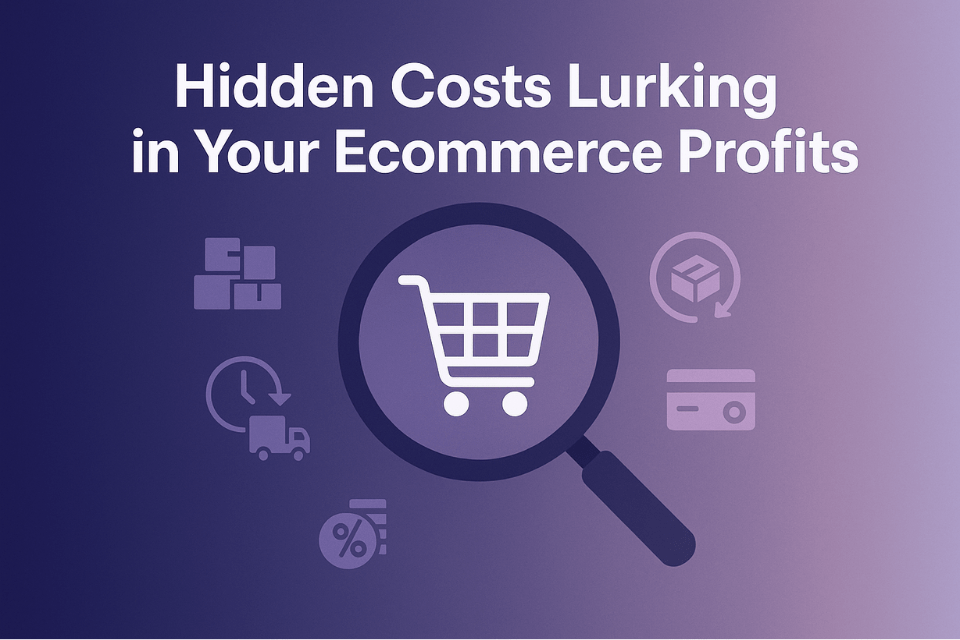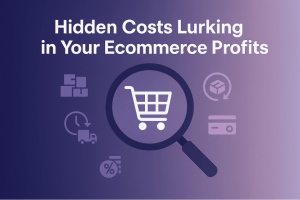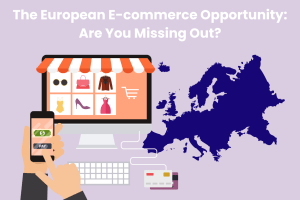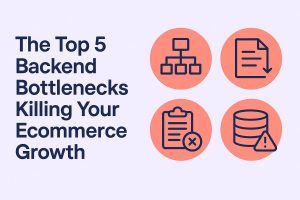Ecommerce promises global reach and low overhead, drawing many sellers to platforms like Amazon and Shopify. In practice, however, unexpected fees can quietly eat away at your margins. As one expert notes, what starts as a “profitable dream” often comes with “unexpected costs that leech profit margins”. Savvy sellers recognize that platform fees, processing charges, returns, and other hidden expenses must be managed carefully. Below, we’ll explore six common hidden costs in ecommerce and how to keep your profits healthy.
Platform Fees (Amazon, Shopify, etc.)
Sellers face upfront and ongoing charges simply to use ecommerce platforms. For example, Amazon charges a referral fee on every sale – a percentage of the item price that varies by category (often around 9–15%). Amazon also has subscription plans: an Individual seller pays $0.99 per item, while a Professional plan is $39.99/month for higher-volume sellers. These add to costs whether or not you use Fulfillment by Amazon (FBA).
Shopify and similar platforms have monthly subscription fees plus additional transaction charges. Shopify’s basic plan costs $39/month and still charges around 2% per sale if you use an external payment gateway. Even if you use Shopify Payments, you’ll pay card processing fees (e.g. 2.9% + $0.30). And many Shopify apps or themes carry extra fees. In short, platform plans can seem affordable at first, but add-ons and commissions mount up over time. Sellers should always factor in subscription, listing, and referral fees when calculating profit.
Payment Processing Fees
Beyond platform costs, payment gateways cut into your revenue. Most payment processors (Stripe, PayPal, Square, etc.) charge around 3% plus $0.30 per transaction. These seemingly small fees add up quickly: for a $100 sale, you lose about $3 to the processor. High-volume sellers may negotiate lower rates, but merchant fees remain a significant expense. There may be extra charges for international cards, currency conversion, or micropayments on small orders.
- Typical fees: ~2.5–3.5% + $0.10–$0.30 per transaction.
- Cross-border/Currency: Additional 1–3% for foreign cards or currency conversion.
- Micropayment surcharges: Some processors add fees for very low-price items.

By tracking total payment fees per month, sellers can see how much of each sale is “lost” before it hits their bank account. Over hundreds of transactions, this hidden cost can reach thousands of dollars. Optimizing pricing and considering alternative gateways can help, but it’s crucial to include these fees in profit calculations.
Returns and Refunds
Online shoppers expect easy returns, but processing them is costly. Ecommerce return rates are surprisingly high – roughly 17% on average in 2024. During holiday seasons or in apparel, rates can approach 20–30%. Every returned item costs money: you often refund the customer and incur shipping back, restocking, and repackaging costs. One study estimates the cost to process a return at 20–65% of the item’s value, not counting lost productivity.
High return rates “make your predictive sales and profit tracking feel unpredictable,” notes Shopify. For a $50 item, a 20% processing cost is $10 wasted each time it’s returned. (And some marketplaces even refund only 80% of their selling fee on returns, further hurting sellers.)
- Direct costs: Return shipping, inspection, repackaging, and disposal of unsellable goods.
- Indirect costs: Restocking fees, customer service workload, and the capital tied up in unsold stock.
Mitigating returns is key: clear product descriptions, accurate sizing guides, and prompt customer service can help. Some brands limit free returns or add restocking fees to share the burden. At minimum, build a conservative return rate into your margin calculations so a spike in returns doesn’t erase profitability.
Customer Acquisition Costs (CAC)
Selling products online almost always requires marketing – and marketing costs money. Customer Acquisition Cost (CAC) measures how much you spend (ads, promotions, etc.) to gain one new buyer. In ecommerce, CAC can easily be tens to hundreds of dollars per customer. Industry benchmarks show averages around $53–$91 per acquisition depending on sector. For example, food & beverage brands averaged $53, while jewelry averaged $91 per new customer. Highly competitive niches or premium products may see even higher CAC.
- Advertising: Pay-per-click, social ads, influencer partnerships, and coupon campaigns can generate sales but at high cost.
- Organic vs. Paid: Relying solely on ads means each new order has a built-in marketing price. Investing in SEO, content, and email lists can lower long-term CAC.
If your average order is $30 but you spend $40 to acquire the customer, you’re losing money. Aim for a healthy ratio: ideally the lifetime value (LTV) of a customer should be 3–4 times your CAC. Carefully tracking ad spend and conversions lets you adjust your budget. Many ecommerce firms use tools or agencies to monitor ROI by channel. The key point: acquisition is not “free” – it’s a hidden cost that directly reduces margins if not managed.
Inventory Holding and Storage
Carrying inventory is expensive. Warehouses, insurance, taxes, and capital costs all add up. On average, inventory carrying costs run about 20–30% of the inventory’s value per year. In practical terms, if you hold $100,000 of goods, expect $20K–$30K in related costs annually. These include rent for storage space, utilities, security, insurance, and inventory taxes.
For example, a fulfillment center might charge roughly $0.78 per cubic foot per month in non-peak season – rising to $2.40/cu.ft during holidays. Amazon FBA sellers face these same fees: any unsold inventory lingering in Amazon’s warehouse can trigger “long-term storage” surcharges. Overstocked or slow-moving products often incur extra fees.
- Warehousing: Even self-fulfilling sellers pay for space (owning vs. renting), shelving, and staff to manage stock.
- Financing costs: Money invested in unsold stock is capital that could be used elsewhere (opportunity cost).
- Obsolescence: Products become outdated or perish, requiring markdowns or disposal.
Smart inventory management is vital. Techniques like just-in-time stocking, demand forecasting, and inventory optimization can reduce holding costs. Some sellers use 3PL providers to scale up storage without long-term leases. At a minimum, recognize that inventory is not “free” – its carrying cost can erode profits even if sales are strong.
Compliance and Taxes
Regulatory and tax obligations are the most neglected hidden costs. Online sellers must juggle data security, sales taxes, and product compliance:
- Data & Security: SSL certificates, secure hosting, and PCI compliance (if handling credit cards) are mandatory. Regulations like GDPR (in the EU) and CCPA (California) require strict data protection, or the business faces heavy fines. SSL certificates and compliance scans are small per-item expenses that add up – and non-compliance is risky.
- Sales Tax/VAT: Each region has different rules. In the US, you may need to collect sales tax in any state where you have “nexus” (inventory, employees, etc.). Globally, VAT and import duties vary by country. A marketplace might handle some taxes, but sellers often must register and remit taxes in multiple jurisdictions.
- Industry Regulations: Some products need certifications (FDA for supplements, FCC for electronics, etc.), which involve testing fees and licenses.
Failing to account for these costs can lead to audits, penalties, and fines. (For perspective, EU GDPR fines can reach up to 4% of annual revenue.) Many sellers use tax automation tools (like Avalara or TaxJar) to reduce headaches, but those subscriptions themselves are another expense. At a minimum, budget for professional advice and compliance software if selling across state or national borders.
Conclusion
Ecommerce can be lucrative, but only if you account for the hidden costs that cut into profit. High platform fees, processing charges, returns, marketing spend, inventory costs, and compliance burdens all add up. Savvy sellers monitor these areas closely. Track every percentage and dollar: for example, calculate your true profit on Amazon or Shopify by including referral and transaction fees upfront. Use analytics to see your real return on advertising spend. Tighten up returns with clear policies and better product information. Manage stock smartly to avoid long-term storage fees.
By staying aware of these hidden costs, you can protect your margins and make smarter decisions. ToolEcommerce.com provides resources, insights, and tools to help ecommerce sellers optimize operations and boost profitability. Whether you use spreadsheets, software apps, or expert advice, the goal is the same: keep those costs visible and under control. Arm yourself with knowledge today – and visit ToolEcommerce.com for guides, tools, and support to help maximize your ecommerce profits.





